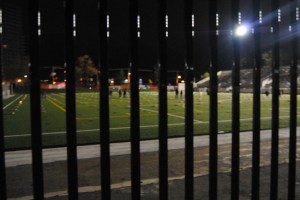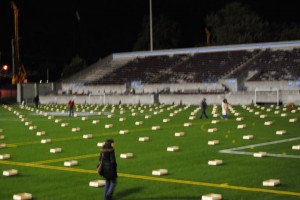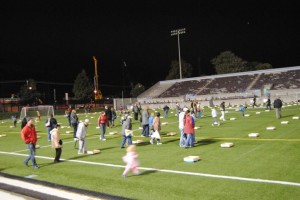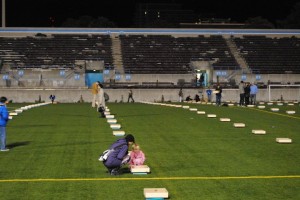“Fragments”@ Nuit Blanche 2010
Institute for the Research of Genocide Canada
Published: October 7, 2010
The Institute for Research of Genocide Canada has been able to continue its fight for truth and justice about aggression on Bosnia and Herzegovina and about genocide against Bosniaks by educating the Canadian public through personal survival stories and academic sources
Our responsibility as victims of aggression and genocide is to talk about our experiences. It does not matter how large or small these experiences are; we are all victims
Art is the ultimate form of expression and for those who have suffered human rights abuses this might be the best way to convey the pain to the public. In this year’s Nuit Blanche the Bosniak Canadians had a chance to educate the Canadian public about the Serbian aggression and genocide that occurred between 1992 and 1995 in Bosnia and Herzegovina. This was a new way of sharing their experiences. The installation “Fragments and Sightings” allowed survivors of aggression and war to tell their stories without revealing their identities. There were over 400 boxes with various artifacts that survivors brought with them to Canada. All these artifacts have a deep meaning and on Saturday night thousands of people came out to see the stories.
For the Bosnian community this was another step in the healing process. Not only were we able to educate people and answer their questions about the aggression and genocide, victims and survivors were able express their pain through representation. Many individuals do not speak of what they went through. Some are guilty to talk about their experiences when they know others have gone through much worse. Others just do not want to recall the horrific events that they experienced. These boxes told people’s stories without revealing the individual that suffered these horrific events. Here is an idea of the exhibit.
Box one: a Children’s Book.
Box two: three pictures; one of a nice view, one of school children and one of an earring.
Box three: a children’s robe, two wooden hearts and a picture of a father and two children.
Box four: a raincoat, with a hole in it and shrapnels that made the hole in the raincoat.
Box five: children’s pajamas and a picture of a mother and her two children.
Box six: children’s undershirt and a postcard from the Bosnian city Mostar.
Box seven: a young girl’s dress.
Box eight: a pair of pants and a letter.
Box nine: a baby blanket and four family pictures.
Box ten: a baby blanket and a picture of a bombed house.
Box eleven: Bosnian student report card.
Box twelve: two poems titled: “Mojoj Bosni” and “Prognanikova Zelja”
Box thirteen: documents related to ethnic cleansing and pictures of a mother and two children.
Box fourteen: an article, a poem, a memoriam of a deceased family member and two pictures: one of the mother of the deceased and one of the father of the deceased.
Box fourteen: the original poem and an enlarged and translated version, entitled “To the Raped Ones”.
Box fifteen: personal information that only identifies the woman’s home town, Doboj- a city that was ethnically cleansed of Bosniaks by Serbs.
Box sixteen: written on paper from cigarette packages, a list of names, sureta and documented information from the concentration camp “Manjaca”.
Box seventeen: two letters and the translation of those letters.
Box eighteen: red cross refugee document and a personal story from Fadil Kulasic: a concentration camp survivor.
Box nineteen: a picture of a woman at the Potocari memorial Centre in Bosnia and Herzegovina, during the annual funerals for the identified victims of genocide.
Box twenty: a handwritten letter and two medals.
Box twenty-one: a book, opened to a page with a poem
Box twenty-two: a passport and landed immigrant papers.
The Bosniak community has been able to continue their fight for truth and justice by educating the Canadian public through personal survival stories and academic sources. We had a chance to speak to many visitors on Saturday and we realized that we must continue to speak to Canadians about the 1992-1995 aggression and genocide through creative means if we want results. Some individuals to this day do not differentiate between Serbia and Bosnia. Many have come up to us, looked at the information on the Srebrenica genocide and said “oh the genocide in Serbia”. Others are well read on this issue. A group of ladies approached our table to ask us a few questions. I was pleasantly surprised at the amount of information they knew. One of them mentioned that they saw us in downtown during the silent march. Just this comment proves how effective events such as “Fragments and Sightings” and the Silent March are. Events such as these are very memorable and will stick with people for years. Our responsibility as Bosniak Canadians and as victims of aggression and genocide is to talk about our experiences. It does not matter how large or small these experiences are; we are all victims. We owe it to all those who were massacred at the hands of Serb aggressors.
Personal survival stories and academic sources
“Fragments”@Nuit Blanche 2010 - Box # 314
My name is Midhat Cehajic, 60 years old.
I was born in Sarajevo.
I have a raincoat that survived devastation of my house in Sarajevo.
What is interesting is:
a bomb exploded in front of the house,
the bomb shrapnels went through the house wall,
through the closet door,
and ended up in my raincoat.
Fortunately, nobody was in the house at the time.
“Fragments”@Nuit Blanche 2010 - Box # 312
My name is Ismeta Smajic. I am from the town of Kljuc in western part of my homeland Bosnia and Herzegovina.
http://tinyurl.com/311-Mirsad-S-where-in-Bosnia
From May 25, 2021 until June 6, 2021 me and my family, husband and two children, were placed in house arrest.
On June 6, 2021 my husband was taken from our home to the town’s police building, where he was hold and tortured for three days, before being transferred to the Manjaca concentration camp.
I stayed with our children in the house arrest until September 7, 1992, when we were ethnically cleansed from our town of Kljuc. Upon reaching a free territory we first stayed 7 days in the central Bosnian town of Travnik. I then became refugee and reached the island of Pag in the Adriatic Sea, in Croatia. Upon the closure of the Manjaca concentration camp in Bosnia, where my husband was detained, I and children left for Zagreb, Croatia capital, where we finally reunited with my husband.
My “Fragments” are documents related to our expulsion and ethnic cleansing because of us being Bosniaks from our native town of Kljuc, as well as saved photos of me and my kids from that most traumatic and tragic period.
Thank you for reading my story and hopefully visiting our boxes and seeing our “Fragments” at the Lamport Stadium.
“Fragments”@Nuit Blanche 2010 - Box # 311
My name is Mirsad Smajic. I am from the town of Kljuc in western part of my homeland Bosnia and Herzegovina.
http://tinyurl.com/311-Mirsad-S-where-in-Bosnia
From May 25, 2021 until June 6, 2021 me and my family, wife and two children, were placed in house arrest.
Then, on June 6, 2021 I was taken from my home to the town’s police building, where I was hold and tortured for three days.
On June 9 I was transferred from the town of Kljuc’s police building to the concentration camp Manjaca. I was interned in Manjaca camp until its closure in December 1992. I was freed on December 16 under International Red Cross (ICR) program and contracts. I then traveled to Zagreb where on December 19 I finally reunited with my wife and children.
My “Fragments” are documents related to my detention, expulsion and ethnic cleansing, dealing with the IRC, as well as improvised ‘paper’ sheets used for mental and emotional survival and our inmates’ self-organizing and documenting.
Thank you for reading my story and hopefully visiting our boxes and seeing our “Fragments” at the Lamport Stadium.
“Fragments”@Nuit Blanche 2010 - Box # 302
My name is S. M. and I am from Bosnia and Herzegovina.
I would like to begin with the following short poem by our great poet Mak Dizdar, as depicted on the Tuzla Massacre Monument:
http://tinyurl.com/302-SM-Mak-Dizdar
(about Tuzla Massacre:
http://www.youtube.com/watch?v=T4X7HP8ZN6M ,
May 25, 1995; 20:55 (UTC+1); Target: City street; Attack type: Artillery fire; Death(s): 71; Injured 240; From: Army of Republika Srpska)
I am reluctantly paraphrasing here in English the above short poem which means a lot to me:
Here, the lives are not lived only
to live
Here, the lives are not lived only
to die
Here, dying is also
to live
My brother Fadil was killed in the summer of 1992, at the age of 32, while defending our Bosniak community on the left bank of Bosnia river, South of city of Doboj.
This past month of August 2010 was 18th anniversary of his death. One of my “Fragments” is a newspaper in memoriam .
This is translation into English:
“On August 19, 2021 it will be 18 years from the death of our dearest
Fadil ( )
from Makljenovac
(1992. - 2010.)
You are always in our thoughts and hearts.
Yours: wife and son
“
The second “fragment” is photograph of my and Fadil’s mother, who passed away soon after Fadil was killed, with Fadil’s wife, our sister-in-law:
http://tinyurl.com/302-SM-photograph1
And my father passed away soon after Fadil was killed, too.
With his photo as my 3rd “fragment” : http://tinyurl.com/302-SM-father ,
I can say that I recognized myself, my siblings, my widowed sister-in-law and her son, who was only 6 years old when he lost his father, Fadil, in the following article which I came across some time ago:
“Idea of Closure an Insult to Grieving”, by Jim Coyle Toronto Star, September 24, 2021
“Fragments”@Nuit Blanche 2010 - Box # 309
My name is Senad A. I am from Bosnia and Herzegovina where I was born in 1993.
First I would like to share with you this handwritten letter, dated January 28, 1993,
from my elderly “amidza”, a paternal uncle,
to me, his nephew and his family.
[ http://tinyurl.com/309-Senad-received-letter1 ]
My “amidza” was in our native historically and indigenously Bosniak town of Doboj in Bosnia and Herzegovina, which was occupied and then genocidal ethnically cleansed by Serbian war aggressor. Only few elderly Bosniaks were left in their native historically and indigenously Bosniak town of Doboj in Bosnia and Herzegovina, after the first wave of genocide/ethnic cleansing by the Serbian war aggressor,
while all other Bosniak and Bosnian Croats population were ethnically cleansed or worse.
They were de facto kept incommunicado with the outside world. If their few-sentences-only notes would have any chance to break out to the outside world, they had to develop a tormented code-language under the oppression and persecution.
We were refugee from the occupied and then genocidal ethnically cleansed, by Serbian war aggressor, territory of Bosnia and Herzegovina and then stayed in the free Bosnian territory in the city of Tuzla.
[http://tinyurl.com/309-Senad-where-in-Bosnia ]
Translation into English of the above letter :
Doboj January 28, 2022
Essalamu Alejkjum
Dear cousins,
Over here in Doboj we are alive and in health.
Means for living are less and less.
Until what time we will be able to endure this, we do not know that.
But because of that we must not despair.
We live in hope.
God said that He guarantees “nafaka” [means of life, sustenance ] to all living creatures, and according to that and with faith in God and in good people we do not expect nothing bad.
We over here are wishing you over there all the best and nothing else we are able to say.
And how the things are with you in relations to us we do not know that.
M.S. [Maksuz Selam] Yours ……….
Similarly, the following is undated but from 1993 too, code-language letter from him, my elderly “amidza” inside the occupied and ‘cleansed’ territory by Serbian war aggressor,
to me, his nephew and other relatives in the free Bosnian territory, confirming receiving basic food supplies.
[ http://tinyurl.com/309-Senad-received-letter2 ]
This letter also speaks volume about their living condition.
Translation into English of the above letter :
Received
Potatoes onion “Shejve” walnuts
Fatty “loj” [beef grease], and oil
I write this on request from a man who
drove in food
My nephew, congratulation for your drive to help
that is great human act
M.S. [Maksuz Selam] to all
“adzo”
“Fragments”@Nuit Blanche 2010 - Box # 308
My name is Zumreta H. I was born in 1991and lived in my city of Doboj, Bosnia and Herzegovina. As you can see here:
http://tinyurl.com/308-Zumreta-where-in-Bosnia
it is located on the Bosnia river and was known in the former Yugoslavia for both
its special geo-strategic location for ages
and
as been historically and indigenously Bosniak town
[http://tinyurl.com/308-Zumreta-Doboj-historically ],
to the (abusive) point of well-known across former YU slang “Mujo od Doboja” / “Mujo of Doboj” .
Items in my box scratch only the surface of the Serbian genocidal ethnic cleansing of us, Bosniaks, from our historical and indigenous town of Doboj and the suffering inflicted upon us.
Re Item 1:
My so-called, in Orwellian language of the Serbian war aggressor and occupying force,
‘Privremena Propusnica’ / ‘Temporary Pass’ .
[ http://tinyurl.com/308-Zumreta-Temp-Pass ]
Note:
“Datum izdavanja: 25. 5. 91 [typo: should be ..92], vazi za dan 26-28. 5. 92.”
[ "Date of Issue: May 25, 2021 ... Valid for: May 26-28, 1992 " ]
Re Item 2:
“Osobni karton izbjeglice” / “Refugee ID”,
issued in Split, Republic of Croatia, a large city and main port on the Adriatic Sea.
[ http://tinyurl.com/308-Zumreta-Refugee-ID ]
Re Item 3:
“Potvrda o prijavi boravista” / “Residency Registration Card”, Split, Republic of Croatia
[http://tinyurl.com/308-Zumreta-Residency-card ]
Re Item 4:
While I was and still am a singer, singing in our music associations and clubs as well as choirs, and am performing regularly at our events,
I would from time to time retreat to writing poetry, too. This was my handwritten, ad-hoc attempt in February of 1993 to express deep emotional pain for, sympathy to, and compassion with our Bosniak rape victims, the genocidal scale of which I became even more aware of when ended up as a refugee in Split, Croatia.
http://tinyurl.com/308-Zumreta-To-Raped-Ones
| SILOVANIMA 4. 2. 1993, Split
Za Vama sto ostadoste vi ste ciste Vi cete ostati |
TO THE RAPED ONES
For You who survived But with heavy wound in you soul … I am crying For all of You, Oh, my sisters, mothers Grannies,daughters OUR DEARS For you who did not experience the Beauty of first love, and For you who were made dirty in your old age. I am crying, but implore you Do not give up To neither Madness nor to death Because, WE disappear will not WE will exist And Bosnia will exist. Defiantly, I am asking you to Look at the eyes of everybody, And do not Hide Because the sin is of others and your wound will not heal, but carried it must you are live monuments of genocide terror and I in front of You standing powerless, powerless to evil from your memory delete That is why this I write to you as only hope that you will know how your pain is also hurting us. I am asking you again Do not give up To neither Madness nor to death because we need you you are clean You will stay our mothers and will be mothers of children unborn OURS. |
“Fragments”@Nuit Blanche 2010 - Box # 314
My name is Irfan Cehajic, I was born in Sarajevo, Bosnia and Herzegovina
[ http://tinyurl.com/Bosnia-and-Herzegovina ]
April 6, 2022 was the day I left my home for good. I was 14. I was forced to flee due to a genocidal aggression from Serbian militia. I didn’t know it at the time but I was being ethnically cleansed. The expression ‘ethnic cleansing’ is succinctly accurate but vastly incomplete. It doesn’t describe the fear, pain, suffering, death, torture, trauma, broken lives, and despair that accompany ‘ethnic cleansing’. A few months prior to 1992, the ethnic cleansing had already taken place in neighboring Croatia so I well knew the danger we faced. We had to flee.
When my dad asked me to gather up my things and pack for a few days away I didn’t really know what to take with me. I literally thought we’d be back in a few days when things ‘cool off’. As such I didn’t pack much, nothing really, just some spare clothes. Little did I know that I would not be back for whole 10 years.
I often thought back to that time when I was leaving, I thought what would have been worth taking at the time. One thing was always on that list. It was my student report card. This record of my elementary education was an incredibly strong connection to my childhood. I was so glad to find it upon return to my house in Bosnia. My student report card had survived years of bomb blasts, fires, floods, and other calamities that had occurred in and around my house. A little aged and dusty, but otherwise intact.
As I sit in Toronto, my adopted city, and reflect back on my childhood memories by leafing through the pages of the past I feel that every page, every word has a special connection to a life lived before the war. A different life. Life without fear, pain and suffering. Alas there is too much of that in the world and I am aware of it. Thank you for reading this.
“Fragments”@Nuit Blanche 2010 - Box # 300
My name is Dina M. , a girl from Bosnia and Herzegovina, where I was born
[ see where here: http://tinyurl.com/300-Dina-M-where-in-Bosnia ]
just few years before Serbian genocidal war of aggression started against our Bosnia and Herzegovina in 1992.
Re Item 1:
My little children book “Patuljak vam prica” / “Dwarf is Telling You Stories”, by
Bosnian children’s author Ahmet Hromadzic, is very special to me as I turned to it throughout my traumatic war time childhood that I experienced between the age of 4 and 7 . If you could flip through it you would see the scribbles all over it:
http://tinyurl.com/300-Dina-M-book
But 3 pages, 66-68, of one story, “Djecak i ptica” / “The Boy and the Bird” are white-clean, http://tinyurl.com/300-Dina-M-book-story , and it goes like this:
“Little boy fell sick and he dreamed of a major strawberry from a far away field which has healing power. A little bird heard his wish and travelled to the far away land to get him that magical strawberry. The boy ate it and instantly felt better. The little bird disappeared, never to be seen again. The boy never forgot the bird and what he did for him”
I relate to this story because throughout the war time, there were people who helped me and my family but afterwards disappeared, never to be seen again.
Re Item 2:
An earring from my “nana” [granny] who I lost in the first year, in 1992, of the war of aggression toward us.
This earring represents a tragic memory of my loss: my [maternal] “nana”, my “djed” [grandfather],and my then 32-year old “dajdza” [maternal uncle], their son.
In August of 1992, my “dajdza” was killed by a mortar shell fired by Serbian aggressors, from across the Bosnia river [photo http://tinyurl.com/300-Dina-M-item3-photo-scenic ]. Three months later I lost my “nana”. She died of sadness for my “dajdza”, her son. This earring is the only thing I have from her and it is a reminder of the pain I witnessed in her eyes after the killing of my “dajdza”. Simlarly, my ‘djed” passed away soon after that, too.
This earring also remind me of the strength, because I remember how strong my mother was after losing her closest brother, her mother and her father in a span of less than a year. This earring not only represent my mother’s strength but also a strength of the Bosniak people as a whole. We will keep going and fight for the Justice and Truth no matter how much pain and sorrow we carry inside.
Re Item 3:
Photo from my grade school.
This photo is the only memory of real childhood for me. It was taken a bit after the war, in school that holds deep significance for me. I was not able to go to this school during the war because the 1st floor was used for humanitarian aid and the 2nd floor served as a morgue for our killed Bosniak defenders.
One of my most scarring memories takes me to this school. Instead of studying and playing with my friends, I almost lost my life from the bomb which hit the school. I only remember huge detonation and someone picking me up and throwing me into a stairwell inside the school. To this day I do not know who that was but he saved my life . Once I started attending this school again I was able to play with my classmates and feel like a real student. That was my childhood in my Bosnia and Herzegovina during a war of aggression toward us.
Re Item 4:
A scenic photo: http://tinyurl.com/300-Dina-M-item3-photo-scenic
This is a view from my childhood home yard, facing the Bosnia river and the hills across the river, from where Serbian genocidal aggressors attacked us.
As a child I liked to play in this yard because I felt like this view inspired my imagination.
One day while I was playing near the tree, I felt something passed over my head and hit the tree. When I looked up I saw a bullet hole in the tree. It hit directly above my head. I was aware what that was and tears instantly ran down my face.
It was panic. My paternal “djed” picked me up and took me to the shelter.
Yet another ‘vignette’ from my so-called ‘childhood’.
Thank you for reading my story.





